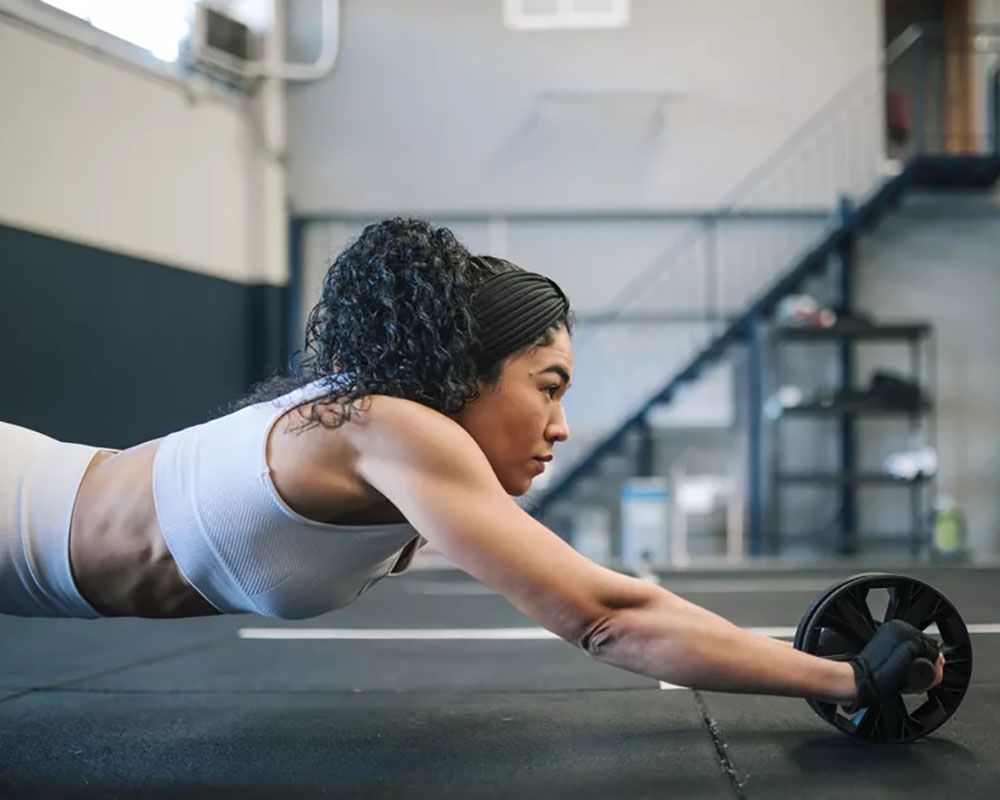How to Use an Ab Roller to Build a Strong, Sculpted Core

If you’ve taken an ab roller for a spin, you’ll know this “innocent at first glance” piece of equipment packs a mighty punch for your abdominal muscles. Not to mention, your entire core. Building a strong, solid core has its benefits both on and off the gym floor. From improved posture and strength, to injury prevention and enhanced daily movement, working the abs, obliques and lower back—the major core muscles—builds your body’s foundation.
As simple as it looks, using the ab roller is an advanced exercise that should only be attempted as you gain core control. Read on to find out what our experts have to say about it.
Meet the Expert
- Tracy Bauer is a Club Pilates GO Instructor
- Matt Kite, BS, CSCS, USAW-L1SP is Director of Education at D1 Training
What Is An Ab Roller?
Ab rollers are designed to glide effortlessly along most floor surfaces. It usually features a wheel at the center (commonly made from a non-slip, durable, and lightweight rubber) and handles at each side. “It’s this wheel, as well as gripping both handles, that forces your core to work in overdrive as you roll it forward and backward,” explains Tracy Bauer, Club Pilates GO Instructor.
Why is it so effective? According to Director of Education at D1 Training Matt Kite: “This piece of training equipment helps you target several muscles of the core during the extension movement”. In short, this means powerful activation of every muscle across your center at once.
Exactly What Muscles Does It Target?
A bunch of muscles are responsible for helping your body fight gravity during the rolling phase. “The ab wheel allows you to train your entire core—your abdominals, glutes, back muscles, and obliques—to work as a unit,” explains Bauer.
Whilst the rectus abdominis (the ‘abs’) is the primary mover, other muscles come into play. “The transverse abdominis, the inner abs and deepest muscle in our core, is also very important as it is primarily responsible for stabilizing the spine and the pelvis,” outlines Kite. The internal and external obliques (located on the side of the stomach) also fire up, and are crucial for executing the movement with proper form.
“The ab roller is an excellent exercise for working the upper body musculature too, including the erector spinae, the stabilizing muscles running the length of your spine, the latissimus dorsi (or lats), the broadest muscles on each side of your back, and your deltoids (shoulders), chest, biceps and triceps,” Bauer adds.
The lats and shoulders are stimulated primarily during the rolling out phase, while your core is worked during the secondary, rolling back stage. Remember, a stronger core benefits the body’s daily function in many ways, such as torso rotation and flexing, as well as protecting your spine.
How To Use The Ab Roller
As mentioned, it might appear simple, but the ab wheel is a tough exercise that commands focus and attention to every muscles at work. “It’s very challenging to execute this motion at a high level when in full extension, which is why I recommend working in short ranges of motion until strength and stability is built overtime,” suggests Kite.
Steps for perfecting the ab roller:
- Kneel on a mat and place the ab wheel in front of you, directly under your shoulders.
- Before you start moving, contract the core by drawing in your belly button up toward your spine, keeping the spine neutral and your back flat.
- Grab onto each side handle and keep your arms straight and stabilized, before slowly rolling the ab wheel out with control.
- Pause just before you feel your back will arch, and slowly return to your starting position by rolling backward, activating the abs the entire time.
- Continue to work on a fuller range of motion by extending your hips further as you gain strength.
Spend 5-10 minutes dynamically warming up the entire body before using the ab roller, encouraging movement in your shoulder joints, lower back and hip flexors.
If you are attempting to use the ab roller for the first time, “start out small,” cautions Bauer. “It’s easy to make the mistake of rolling out too far, but really you should focus on rolling out and back just inches at a time to avoid unnecessary stress on your spine.”
Who Should Avoid It
Given the foundational strength and core control required, the ab roller is not suitable for everyone. “Those with lower back or abdominal injuries should avoid the ab wheel until fully healed and cleared, although, when the core in strengthened, it can actually help prevent strain on the core and lower back,” explains Kite.
The same goes for anyone who has had surgeries on the deep abdominal region. “In which case, use the ab roller with caution or avoid this exercise altogether as it creates tension in this region when extending the muscle groups.”
Also, it’s important to have a basic understanding of your core before giving the ab roller a go. “This equipment requires a strong upper body and solid core stability to master, and it’s therefore typically a workout for a more intermediate or advanced fitness level,” explains Bauer.
Think about it: With just two handles to grip, your upper strength, stability and how you use your core muscles needs to be top notch to fluidly work the entire chain of muscles. So before you dive into ab rolling, Bauer suggests building on your core exercises, such as plank holds, plank with leg and arm lifts, and stability ball holds to build a solid base.
The Takeaway
The ab roller is a small, yet robust piece of equipment that fully activates the core muscles and the upper body. It features a wheel, attached with a handle on each side, that smoothly glides along most surfaces.
When performed with precision, this movement is one of the ultimate challenges for generating next level core strength. The exercise requires strength and stability for proper execution, and therefore should only be attempted if you have a solid fitness foundation. In addition, given the tension it places on your abdominal region, it’s not suitable for anyone experiencing lower back, spine or abdominal injuries.
14 Ab Exercises You Can Do While Watching Netflix in Bed








